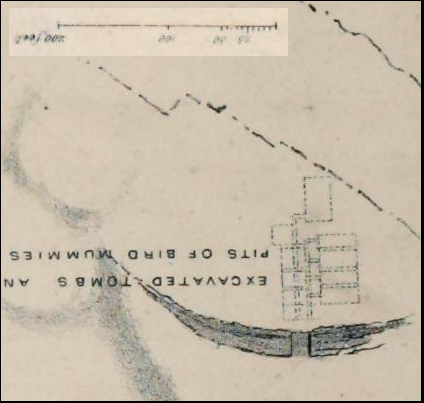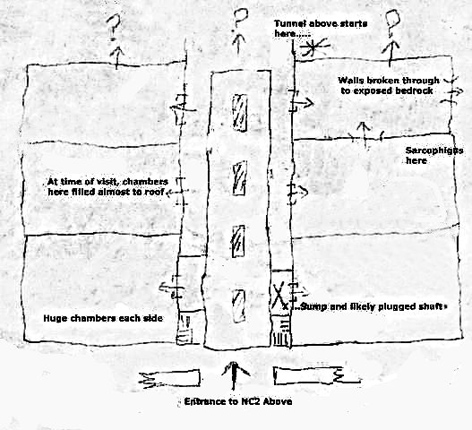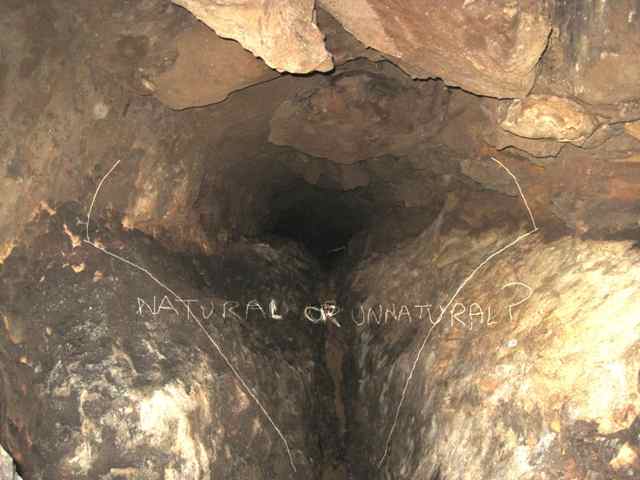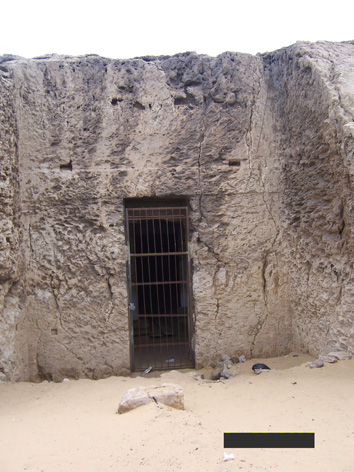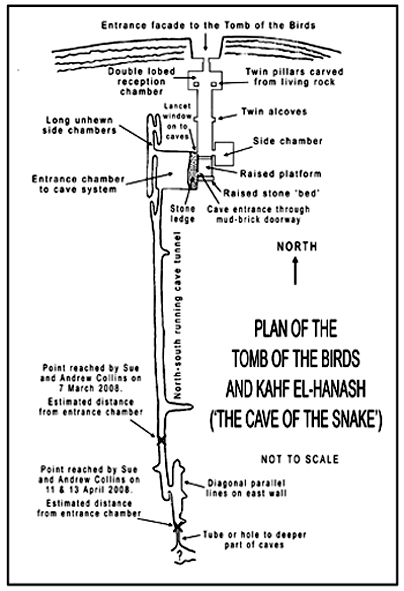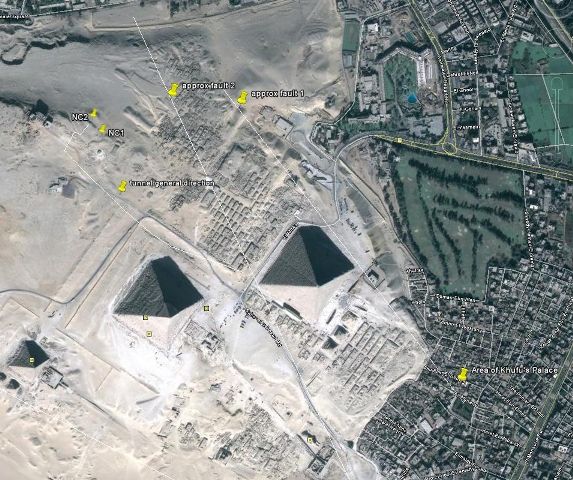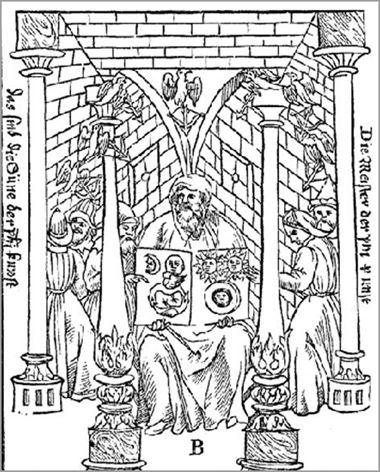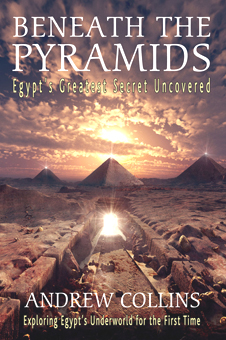![]()
![]()
EL-KAHF
EL-HANASH
(THE CAVE OF THE SNAKE)
GIZA'S CAVE
UNDERWORLD EXPLORED ONCE MORE
REVIEWING RICHARD GABRIEL'S LATEST ONLINE FEATURE IN THE WAKE OF HIS OWN VISIT TO THE CAVES IN NOVEMBER 2009
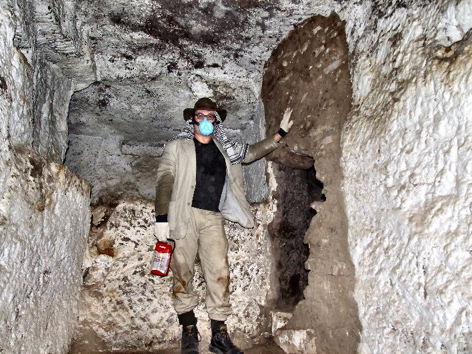
Andrew
Collins emerges from Giza's cave underworld in April 2008.
A Report by Andrew Collins
Alternative
Egypt researcher Richard Gabriel has posted a new
feature on richardgabriel.info
that includes a number of new photos of Giza's cave world, and the underground
galleries beneath the Tomb of the Birds (NC2). In the wake of the closure of the
Tomb of the Birds, through which access is gained to the caves, Richard's testimony
and thoughts following his own visit there in November 2009, along with our own
investigations and findings after discovering and exploring the caves in March
and April 2008, now become the sole modern-day information available on the subject
until Dr Hawass's report of his own investigation of the site is published.
The Underground Galleries
I am pleased to see that Richard has drawn a rough plan of the underground galleries and chambers located beneath the Tomb of the Birds, which were cleared and explored by Dr Zahi Hawass and his team in 2009. What I hadn't realized is that the north-south orientated galleries are linked beneath the tomb's main ground level corridor by a series of arches set between stone pillars, something that was never indicated in the plan of the complex done by British engineer John Shae Perring in c. 1839-1842. Indeed, both Nigel Skinner Simpson and myself have written to Richard asking if he can reconcile any differences between Perring's plan and his own memory of the underground complex's layout. Technical engineer Rodney Hale has merged Richard's rough plan with a blow up of Perring's original (show below). This I sent to Richard for comment, to which he responded: "I think you got it about right, although my sketch needs to be scaled down. (email to AC April 29, 2010)"
Richard says that in the western part of the galleries is a sump in the floor that might well lead to a deeper level, perhaps even the natural caves. This is possible. He says also that holes in the south and west walls of this same gallery, penetrate into the natural bedrock. If we examine Perring's plan we can see these same holes in the south and west walls of the chambers positioned in the southwest corner of the underground complex. They enable access to tunnels that connect with two further large chambers, two of four aligned north-south and offset to the west of the main subterranean galleries. Other similar holes elsewhere in the same gallery must link with tunnels leading into the other two chambers drawn by Perring and shown as connected via small east-west running tunnels to this same gallery.
Perring's plan of the Tomb of the Birds (NC2) from 1839-1842, upside down. South being up. Compare this against Richard Gabriel's rough plan of the underground galleries cleared by Dr Hawass and his team in 2009. Is the big chamber in southwest corner the Dome or Opening Chamber of the cave complex, accessed via the tomb's ground floor level? I think so, but Nigel Skinner Simpson disagrees, suggesting that everything Perring drew here is on the lower level of the tomb. |
Richard Gabriel's rough plan of the underground galleries accessed from stairs just inside the tomb NC2. Notes the holes in the top right corner (southwest extreme) where the walls penetrate through into the bedrock. Do these tunnels lead to two of the four offset chambers drawn by Perring, and explored by him and Richard Howard Vyse in 1837? Note the north-south placement of the line of pillars along the center of the galleries. |
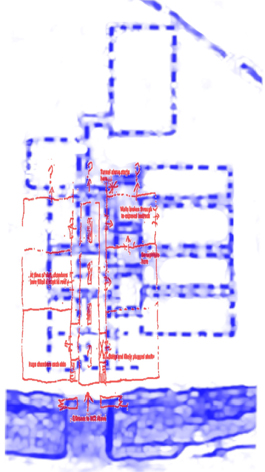 | Left, Perring's plan of the Tomb of the Birds (NC2) in blue with Richard Gabriel's rough plan of the underground galleries and chambers investigated by Hawass and his team in 2009 in red (and sqeezed slightly). Note the lack of correspondence between the large southerly chamber at the top, another chamber in the southeast, and the alignment of four chambers in the west. None of these features on Richard's plan were seemingly entered by him, since they were probably still unaccessible. Richard's comment on seeing this overlay was "I think you got it about right, although my sketch needs to be scaled down. (email to AC April 29, 2010)" (Pic credit: Rodney Hale after Perring and Gabriel). |
This leaves one big chamber on Perring's plan, which has yet to be identified. It is placed in the southwest corner, and corresponds to the position of the large partly-hewn chamber entered via the ground-level area of the tomb (this we christened "the Dome" or the "Opening Chamber" following our rediscovery of the site in March 2008). This allows access to the natural caves proper, which are nowhere to be seen on Perring's plan.
Gourds
and Chamber Pots
In one photo of the underground galleries, Richard highlights a vertical fissure in the rock walls, which he states is "stacked high with gourds many becoming calcified". Unfortunately, I struggle to see what he sees in this picture. It is possible that he's correct? My colleague Nigel Skinner Simpson says that this is exactly what one would expect to see embedded in the walls of an animal/bird necropolis. As he states: "The ancient Egyptians would cut side galleries and niches, stack them full with burials and then seal them up. The niches and galleries could be almost any size, large or small." Having said this, he does say that what Richard Gabriel identifies as gourds may not be what it seems. On the other hand, on quite separate pictures offered by Richard of the cave interior, Nigel points out that there are text book examples of sealed pots that most likely contain bird or animal burials, convincing him even further that the caves were indeed used as a bird and animal necropolis.
Key Hole Profile in the Caves
Showing an image of the cave's key-hole shaped profile in one area of the complex, Richard asks whether what we see is "natural or unnatural?". I can categorically state that this shape, and the smoothness of the walls seen in many photos, makes it clear that the caves are of natural origin.
Richard Gabriel photo showing the key-hole profile of this section of the cave, suggesting both phreatic (circular) and vadose (v-shape) creation through the presence of rainwater (credit: Richard Gabriel). |
Limestone, like that present in the Giza bedrock, is dissolved over time by the CO2 content of rainwater taking the path of least resistance through natural faults in the rock.
Where this occurs above the local water table, the resulting caves are v-shaped in profile, being caused as the water erodes away the rock, as opposed to dissolving it. This type of cave is described by geologists as vadose.
Where water flowing through faulting actually passes beneath the water line of the local water table, it moves more slowly and actually dissolves (as opposed to eroding) the rock, enlarging the cracks and fissures in the process. The resulting cave passages are circular in profile, and tube shaped in appearance. This type of cave is described as phreatic.
Where the two types of cave - phreatic (circular) and vadose (v-shape) are found together, one on top of the other, creating a key-hole shaped profile (as in Richard's photo), it means both types of cave creation were involved. Initially, the rainwater has passed through the fissures beneath the water table, carving circular caves. Then afterwards, when the water table lowers, if the water continues to flow through the caves, it carves a v-shaped trough at the base of the circular profile, producing a perfect key-hole shaped profile, which is what we see in the picture.
Since this is seen in the caves at Giza, it implies that at first the rainwater must have flowed beneath the level of the water table, but then at some point this water table lowered, creating the profile we see today. Thus parts of the Giza caves are both phreatic and vadose in nature.
The fact that the cave walls are often smooth, particularly in the deeper areas, is further confirmation of their creation by rain water, for as one correspondent on the subject of cave formation at Giza has noted:
"The smooth black layers [seen in the photos] are magnetite [Iron(II,III) oxide (Fe3O4) or ferrous ferric oxide], note that Magnetite forms readily when iron oxidizes underwater. This fact plus the smoothness of the layers confirms that these passages were originally flooded, i.e. phreatic in their formation."
"To summarise the plateau was at one time fully saturated, either under water or continuously subjected to torrential rains. This water flowed through natural fault lines creating phreatic passages and caves. As the rainfall eased the water table fell and passages became vadose in shape.
"This fall in the water table was slow enough to allow magnetite to form in the lower passages.
"Roughly parallel events can be seen in the Cheddar cave systems although more intense as there was also ice melt as well as rainfall."
Swallets
and Resurgencies
This same correspondent, well versed in the subject of cave formation, goes on to suggest that we look for "swallets" and "resurgencies", holes through which the rainwater originally found entrance into the faulting to create the caves in the first place. These, he thinks, will most probably be inactive now, the entrances hidden by sand. Swallets, he says, are found mostly on hills, while resergencies are located generally at the base of hills.
The most obvious swallet, as a point of entry for the rainwater that created the caves at Giza, must have occupied a position now taken by the entrance to the Tomb of the Birds, which is located close to the highest point on the plateau. It is likely that at some point in dynastic times the crack or fissure leading into the caves, was expanded to create the rectilinear structures seen today inside the tomb. In doing so, the ancient Egyptians created an access point into the cave system, which was afterwards, perhaps, sealed off using stone and mortar.
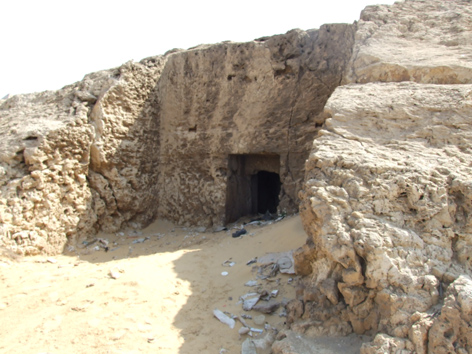 Above, the facade and entrance to the Tomb of the Birds (NC2) in Giza's north cliff, and right, its entrance as seen in March 2010 with a gate cemented in place. Was this the location of a swallet, a fissure that allowed rainwater to enter into the bedrock and carve out the caves prior to the existence of the tomb? Were the caves accessible prior to the Pyramid age?. |
Pic credit: Larry Hunter, 2010. |
In a personal email to me, Dr Hawass alluded to the tomb NC2 as being of Old Kingdom construction. If this is correct, and counters his earlier assertions that the tomb is of Late Dynastic origin, then it means that the caves were certainly accessible during the Pyramid age. Yet if the Tomb of the Birds began as a swallet, then it suggests that the caves might have been accessible long before this time.
One of the most obvious resurgencies found in association with the Giza cave complex is a spring in the southwest corner of the plateau. Located today in the local cemetery beneath the gaze of Gebel Gibli, the southern mount, its is said by the inhabitants of the nearby village of Nazlet el-Samman, to be an entrance into an underground tunnel system. We have even spoken to a local person who has actually been down the well and seen horizontal shafts at its base heading away towards the east and west.
Without knowing of the existence of this well, known as Bir el-Samman, my geological correspondent wrote: "At Giza if there is an active spring or springs at the foot of the plateau there must be a source of water in the lower cave passages, either seepage or an actual trickle along the cave floor.
"To verify a connection one normally adds fluorescent dye to the water, a harmless and highly visible dye, then look to see if this appears in the spring water."
All this throws new light on the formation of the Giza caves, which seem unquestionably to be natural in origin, yet utilised by man once exposed. As to their age, this is difficult: they could have formed any time between the beginning of the Middle Palaeolithic era andthe end of the Late Palaeolithic age, thus between 250,000 years ago and 12,000 years ago.
The
Stone Tube
On page 4 of Richard's fascinating cave article, he focuses on what we call the stone tube in the farthest compartment reached by ourselves in April 2008 and by Richard and his partner Judith in November 2009. It is orientated north-south, appears to be about 3-4 metres in length, and is no more than a 70-80 cms in diameter. Our speculation is that it connects with a further east-west orientated chamber just beyond its exit. If so, then this could be the beginning of the proposed southwest extension of the caves as they head out towards the direction of the Second Pyramid. Certainly, this is what I proposed in my book Beneath the Pyramids last year, and it is what Richard believes too.
The layout of the Tomb of the Birds and connected caves, showing the farthest points reached during our visits in March and April 2008. | Richard says that in the photos of the compartment containing the stone tube he has identified a sealed entrance and plugged tube. Nigel has suggested that these might just conceal more bird or animal burials. Yet as Nigel goes on to write, the bigger question is whether or not the stone tube does indeed provide access to a deeper section of the caves. This is something we might now never find out. Oh, how we wish that we had gone further on our final visits to the caves in April 2008. What does lie beyond the stone tube? You can speculate, as I have done, but no one knows, unless, that is, Dr Hawass and his team did what we now only dream of and went further. |
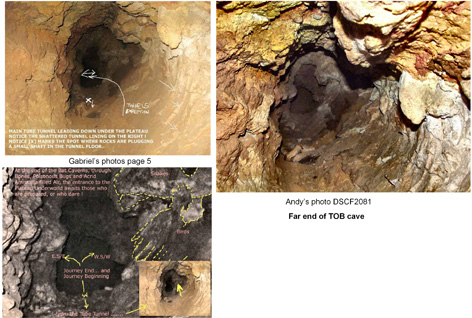 | Two pictures far left, top and bottom, from Richard Gabriel showing the stone tube at the far end of the caves accessed via the Tomb of the Birds. Note the hollow space at the end of my own picture of the stone tube, right, indicating that beyond it is yet another cave compartment. Note also the vertical rib-like features on the right hand side of the tube, which to me might easily have been seen as the interior body of a snake or another animal (Pic credits: left and bottom, Richard Gabriel; right, Andrew Collins). |
Richard Gabriel has responded to our queries regarding the gourds and concealment niches in the following manner:
I accept the possibility which Nigel has suggested, that the apparent plugged entrances may well be to conceal side burial chambers [i.e. concealed niches]. This throws up a further question however as the very clear (still sealed) entrances are to be found directly in the niche to the left of where the final tube entrance begins. I could not help wondering why would they have chosen to do it there with the whole of the rest of the chambers to choose from.
I answer myself by saying 'Why not?' ... but if they did so, I must take account of the fact that there seems to be particular reverence with the intense snake representations [simulacra] as we approach the tube entrance. Maybe a compromise would be that if those last plugged entrances 'are' sealed burial niches, that they contain something (animal?) of sufficiently important status to be given the best position just before the tube...(assuming always that the tube does in fact lead below ground)...
There is no doubt of the snakes and gourds etc which have been suspended from the medium in particular roof areas... and there is no doubt of plenty of other unidentified smaller objects embedded too.
Also to answer Nigel's question here regarding layout below the entrance Tomb. I would say that 'some' of what we observed ties to his description, but I will study the old sketch more and feed back with more accuracy later (email to AC April 20, 2010).
These are very interesting observations, and heighten my feelings (as aired here and elsewhere) that the caves had a special connection with snakes.
The Course of the Cave Tunnels
On the opening page of his feature, Richard shows a satellite map of the plateau, marked with his proposed course of the cave tunnels beyond the point that he and his partner reached in November 2009, nearly 20 months after we reached the same point back in April 2008. He offers the prospect that beyond here the caves veer east-southeast towards the Second Pyramid. From here, he says, they follow the course of a "central geological fault line" that continues in an easterly direction to the southwest corner of the Great Pyramid. Richard points out that "old surveys pics" show the extent of the faulting from the Tomb of the Birds (NC2), situated in the northern cliff of the plateau's Mokkatam formation, on toward the Second Pyramid.
As I have revealed elsewhere (and include in a separate feature below), a high resolution radar satellite image of the Giza plateau taken by a German satellite company in July 2007 appears to indicate the presence of geological faulting coincident with the north-south orientation of the caves explored so far (see pictures below). Black shadow lines indicate further faulting that continues east-southeast until it reaches the northwest corner of the Second Pyramid, where it is lost from view. Evidence of local faulting and hollow cavities in the bedrock beneath the Second Pyramid was established in 1977 by a team jointly sponsored by the Stanford Research Institute (SRI) and the Ain Shams University, Cairo, and led by Lambert T. Dolphin.
Should this suspected faulting indicate the course of the caves, then I suspect that it was in this direction that in 1817 British diplomat and explorer Henry Salt and the Italian Giovanni Caviglia travelled "several hundred yards" before coming across spacious chambers, from which further labyrinthine passages. This, I feel, was somewhere in the vicinity of the Second Pyramid.
Regarding Richard's own statements on the route of the caves, I am intrigued to hear that "old survey pics" reveal details of local geological faulting at Giza, and more particularly its presence between the Tomb of the Birds and Khafre's pyramid. Publication of these pictures would help to substantiate our own published speculations regarding the extent of the caves. I would also be interested to learn more of the aforementioned "central geological fault line", in the proximity of the Great Pyramid, a knowledge of which has eluded me until this time.
 | The
section of the TerraSAR-X radar satellite image of the Giza plateau showing a
shadow line corresponding to the course of the cave tunnels explored to date (Picture
credit: Astrium GmbH and the German Aerospace Centre (DLR)). |
| Fig 19 - The curved shadow line on the TerraSAR-X radar satellite map that seems to show the course either of the caves, or localised faulting, which itself might highlight the course of subterranean caves. Not that it disappears on the northwest corner of the Second Pyramid (Astrium GmbH and the German Aerospace Centre (DLR)). |  |
Rock
Art and "Gold" in the Caves?
I read with interest Richard's identification of proposed rock art, rock carvings and artefacts identified from flash photos taken inside the caves. Although it is clear that simulacra exists in the cave tunnels, as it would in any cave, my imagination is not strong enough to see what he sees in these pictures, other than the beautiful snake head simulacrum found in the deepest section explored to date (see page 3 of his feature). I might be failing to see the obvious, but it should be remembered that nothing can be seen down there in the pitch black, and even flash lights reveal very little due to the vastness of the caverns. The only way of gleaning more of what might be down there is to examine any resulting photos.
Richard identifies objects of "gold" down on the cave floor. We did exactly the same after our first two visits in March 2008. Indeed, we thought we had identified part of gilted stave or funerary bed post leaning up against the cave wall. We enhanced the photo as best as possible and became convinced that it was there. However, on our return visits in April 2008 we searched for the object in question, wishing to use its presence to convince the SCA of the site's significance, but found that it was simply a large animal bone.
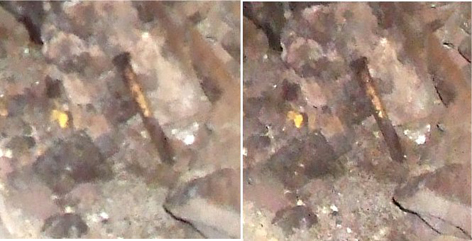 | Two shots of an object seen in the caves on our visits in March 2008 and suspected to be a gilted pole of dynastic manufacture. When we returned back there the following month we realised that the pole was in fact the leg bone of an animal. Appearances can be deceiving when it comes to identifications made from flash photography alone. |
Richard, on page 2 of his feature, seems to fall into the same trap, by showing an animal leg bone, and ringing it as a gold item. You have to be very careful identifying objects simply from flash photos, which tend to distort what is seen by bleaching them out, giving them false colour, and creating confusing shadows around them.
I cannot deny that there is untouched archaeology down in the caves, although without going back to the position where any object has possibly been identified, and checking to find out what it really is, such speculation can be very dangerous.
The same must be said for Richard's identification of apparent rock art in the caves. There is nothing that he has pointed out in his photos that convinces me that this really is genuine rock art of snakes or otherwise. Believe me, I would love this to be the case, but I remain unconvinced. In my opinion, most of the proposed rock art is simply shadows formed by fractures in the rock, or changes between different rock strata, which include seams of iron oxide, possibly siderite or, less likely, haematite (both mined in the past as red ochre).
This red substance seen on the walls of the caves Richard, however, in some instances identifies as evidence of "sand plaster". The earliest and most popular form of plaster used for interior walls in ancient Egypt was made from calcined gypsum, which is similar to the plaster of Paris still used today. In Graeco-Roman times the Greeks did add sand to gypsum to create a mortar that was used as a form of plaster, although I think it unlikely to be what is seen in the flash shot photos under scrutiny here. This is more likely to be naturally forming iron oxide. However, evidence that some form of plaster or stucco was used on the walls of the caves would be an interesting discovery. He also rings more paler features, with incised parallel lines, citing this as sand plaster, although I recall actually examining this same feature, and deciding that it was natural bedrock, which had been cut with a chisel to create the effect seen. This was one of the few things I did manage to spot in the caves simply by using a flash light.
Camel Spiders
Page 4 of Richard's feature also includes some incredible pictures of bats flying along the length of the cave tunnel. There are whole colonies of them down there, and these pictures, better than our own glimpses of the bats captured on film, might finally help identify the species present. Richard, on another page, points out that these "Caverns of the Bats" are home also to an eco-system that includes large bugs and spiders. He has identified the spiders he photographed as camel spiders, which although not fatal to humans, can be very dangerous.
During our own visits to the caves, we tentatively identified the presence of a species of spider named Latrodectus pallidus, the white widow. This species grows to about one inch in size, showing that they are not the species photographed by Richard. These are much larger, perhaps as much as four to five inches in size.
El-kahf
el-hanash (The Cave of the Snake)
Richard speculates that the caves were, and indeed are, the realms of Agathodaimon, the Gnostic and later Sabaean demiurge, that created the physical world. This name means the "good spirit", and there is some evidence that he was worshipped in the form of a giant snake in Egypt during Graeco-Roman times (he is shown in relief as a snake guardian at the entrance to the Kom El Shouqafa catacombs in Alexandria}. There are legends that Agathodaimon and his son Hermes lie buried in or beneath a pyramid at Giza. My own research has indicated that Agathodaimon was associated with the Great Pyramid and the tomb of cave-Hermes with the Second Pyramid.
The connection between Agathodaimon and the Giza plateau is explored in my book Beneath the Pyramids, following our discovery that in local folk tradition, the caves entered via the Tomb of the Birds are thought to be the domain of el-Hanash, a great snake that guards their secrets. I argue in the book that the ancient Egyptians associated snakes with a cave underworld seen in terms of the duat, or netherworld, through which the deceased had to pass on his or her way to an afterlife among the stars.
As I have stated in recent posts, I am positive that the Giza caves have always been seen as the domain of some kind of serpentine deity or spirit, one that was thought to guard this hidden domain. It is even possible that this is confirmed by the existence of snake simulacra of the sort photographed by Richard inside the caves.
I proposed also that the existence of the caves influenced the development of ancient Egyptian thought on the nature of the duat, in particular the section associated with Memphis and Giza, ancient Rostau, in the Am-duat text, which was the domain of the falcon-headed god Sokar. He is shown in depictions of this realm standing upon a great serpent with multiple heads. Yet I say also in Beneath the Pyramids that chthonic snakes were totems of the earth-god Geb, who was himself occasionally shown with the head and neck of a snake. This said, both the goddess Nut, Geb's sister-wife, and Hathor, a female patron of the Giza plateau, were also associated with snakes. Indeed, Hathor, whose cult was intrinsically linked with that of Nut, is connected with snake rock simulacra in at least two places outside of Giza.
It was the local tomb guardian's reference to the caves beyond the Tomb of the Birds as el-kahf, meaning "the cave", and his insistence that they were the abode of el-Hanash, a mythical snake, that led me to name the caves el-kahf el-Hanash, the Cave of the Snake. This then honours local folk tradition regarding the caves, as well as the fact that the tomb guardian who provided this information offered it immediately after our emergence from the caves following their rediscovery in March 2008. This title I would love to be honoured beyond my own writings, even though Dr Hawass himself began calling them "Collins's cave", something that has stuck, at least among certain Egyptological circles.
The
Crocodile God
Richard says that in addition to the influence of Agathodaimon at Giza, the caves are the realm of the crocodile god Sobek, following his identification of rock simulacrum, or rock carving, in the form of a crocodile inside the lower galleries beneath the Tomb of the Birds (see page 2 of his article). Once more, I am unable to make the same connection between the rocky features displayed in Richard's flash photo and the presumed shape of the crocodile's head and neck.
Sobek was a crocodile god whose cult rose in prominence around the end of Egypt's Twelfth Dynasty, c. 1799-1796 BC. It was at this time that the female pharaoh Sobek-nofru, whose name honours the god, is supposed to have completed the fabled Labyrinth, begun by her father Amenenhet III, in the el-Fayium Oasis, some 50 miles (80 km) south of Giza. According to classical sources, this enormous complex of temples and palaces is said to have contained pools of crocodiles, indicating a connection with the cult of Sobek. Several kings from the Thirteenth Dynasty also bore names implying a devotion to Sobek, before the cult would seem to have gone underground until the reign of king Horemheb at the end of the Eighteenth Dynasty, c. 1320 BC.
Draco,
the Dragon
As many of my readers will know, I have written extensively about Sobek-nofru and the cult of Sobek in other works. However, I have found nothing that might convince me that Sobek was worshipped at Giza. Never have the remains of mummified crocodiles ever turned up at Giza, according to the findings of Professor Salima Ikram, the world's foremost expert on animal cults in ancient Egypt.
If there is a crocodile link with the Giza caves, and this has yet to be evidenced, then I would suspect that it relates to the animal seen perched on the back of a hippo in astronomical scenes, mostly from the New Kingdom, and representing the constellation of Draco. In Graeco-Roman times this asterism was most likely associated with the "good spirit" Agathodaimon, the world demiurge believed by the Sabaeans of Harran to repose beneath the plateau.
A connection with Draco, the dragon, is definitely something that Richard and his colleagues Bill and Lucyna Brown, believe is associated with what they call the Giza "geomatrix". They propose that the stars of Draco can be overlaid on the plateau to mark the positions of important underground structures, which Bill and Lucyna have managed to use GPR to try and verify the presence of beneath the plateau. One of these underground sites, somewhere between the Second Pyramid and the large rock-cut tomb of Khentkawes in Giza's central field, Richard alludes to on a separate map as the "Heart Center Temple Complex of the Dragon", indicating its perceived link with Draco.
Despite my own interests in how the constellation of Cygnus, the Northern Cross, might have influenced the evolution of the Giza pyramid field, I also suspect that the influence of the Draco constellation might have played some role in the earliest sky-religion at Giza. Among my lines of enquiry in this respect has been to try and overlay the stars of Draco with key monuments on the plateau. Working, as usual, with technical engineer Rodney Hale, I was unable to find any kind of realistic ground-sky correlation. Perhaps the connection is more subtler, the interest stemming from northerly alignments to the stars of Draco, in particular Alpha Draconis, Thuban (meaning "snake" in Arabic), which acted as Pole Star in the epoch immediately prior to the Pyramid age.
A
Call to Dr Hawass
Richard ends his five-page feature with a call to readers to bombard the office's of Dr Hawass in Cairo with letters and emails asking questions about the cave complex, as well as other discoveries at Giza that would seem to have gone under the radar. He asks also for people to contacts newspapers, magazines and other media sources to ask what they are doing about the subject. I applaud this stance, for now that the Tomb of the Birds is closed to visitors, there are very few routes that anyone other than Dr Hawass and his team can take to explore the matter further.
As I have said before, even though the entrance to the Tomb of the Birds has now been sealed, cave research at Giza continues, and we need the opinions of everyone who might have something important to add to what we already know about them. In this manner, we can build a bigger picture of what is down there in the hope of convincing the media and Egypt's Supreme Council of Antiquities that the caves really are worthy of further exploration. So I thank Richard for admirably contributing to our knowledge of the subject, and look forward to future insights he might wish to share with the world.
Left in my mind is just one thought. Is it really possible that the only people to have got down there into those caves, which Dr Hawass denies exist, is myself, my wife Sue, Nigel Skinner Simpson, Richard Gabriel and his partner Judith? It seems unlikely, but to date I am not aware of anyone else who has done as we have done. Surely, if somebody else had explored them, we would know about it by now. Either that, or they are keeping their mouth shut for a very good reason indeed.
More
incredible is the fact that the shadow line on the TerraSAR-X radar satellite
image seems to connect with another wider shadow line that starts at a position
corresponding to a gully in the plateau's northern cliff, just west of the Tomb
of the Birds, and curves towards the Second Pyramid, where it is finally lost
from sight on the north side of the monument's square base. Once again, there
are no visible features on the corresponding Google satellite map to explain this
anomaly (actually, a second, more fainter, shadow line is also seen on the radar
satellite image. It commences in the proximity of the caves explored so far and
curves towards the Second Pyramid, where it is lost, finally, as it approaches
the west side of the pyramid). Is
it possible that the bird cult once associated with this site honoured Hermes,
the Graeco-Egyptian form of the Egyptian god Thoth, the keeper of ancient records
and guardian of the ancient wisdom? If correct then future excavations inside
the tomb and caves might well reveal that the bird mummies purportedly left here
as ritual offerings (and found by Vyse and Perring in 1837) contained the remains
of ibises, a bird sacred to Thoth-Hermes. If the birds found here were not ibises,
but raptors, such as hawks and falcons, then the cult here was probably that of
Sokar, the guardian of the Duat of Memphis, or Rostau, the ancient name for Giza.
Either solution will go some way to prove that the Tomb of the Birds was seen
as an entrance into a cave underworld.
Hermes
Trismegistus holding the Emerald Tablet. References Dolphin, Lambert T., A. H. Moussa et al, Applications of Modern Sensing Techniques to Egyptology, SRI Institute, Menlo Park, CA, September 1977 Thanks
go out to Ian for his help in attempting to determine the forces behind the creation
of the Giza caves; Robin Rix for putting us in contact; also for Richard Gabriel,
Larry Hunter, Nigel Skinner Simpson and Rodney Hale for their help in putting
their piece together. |
Thanks
go out to Ian for his help in attempting to determine the forces behind the creation
of the Giza caves; Robin Rix for putting us in contact; also for Richard Gabriel,
Larry Hunter, Nigel Skinner Simpson and Rodney Hale for their help in putting
their piece together.
For
more information on the Giza cave discoveries check into this website regularly,
subscribe to the Andrew Collins newsletter, or see Andrew Collins's book BENEATH
THE PYRAMIDS, available now. See below for details of purchase.
For
a comprehensive introduction to Andrew Collins's
new book Beneath the Pyramids,
which features the quest behind the discovery of Egypt's cave underworld, click
here
To
buy BENEATH THE PYRAMIDS, Andrew's new book on the quest to find Giza's cave underworld,
from Amazon click here.
To
buy straight from the publisher, 4th Dimension Press, click here.
Secure
the special edition of BENEATH THE PYRAMIDS signed, numbered and stamped direct
from the author by clicking here and sending
an email with "Beneath the Pyramids" in the contents box (with no final
obligation to buy).
![]()
![]()
